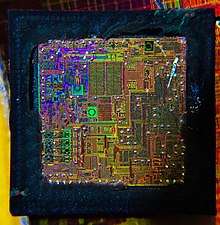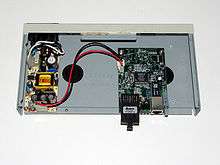Transceiver
In radio communication, a transceiver is a device that is able to both transmit and receive information through a transmission medium. It is a combination of a transmitter and a receiver, hence the name transceiver. Transmission is usually accomplished via radio waves, but communications satellites, wired connections, and optical fiber systems can also be used.
Radio frequency (RF) transceivers are widely used in wireless devices. For example, cell phones use them to connect to cellular networks. Other common examples include walkie-talkies and CB radios. By combining a receiver and transmitter in one consolidated device, a transceiver allows for greater flexibility than what either of these could provide individually.
Despite the widespread use of transceivers, one common system that does not use them is FM radio. In FM radio, receiving and transmitting data are intentionally two separate jobs. Radio stations transmit music, news, and other data over analog radio wave signals (and, more recently, digital signals) and FM radios in homes and cars receive these signals for listeners to enjoy. This system restricts who is allowed to broadcast.
History

The transceiver first appeared in the 1920s. Before then, receivers and transmitters were manufactured separately and devices that wanted to receive and transmit data required both components. Almost all amateur radio equipment today uses transceivers, but there is an active market for pure radio receivers, which are mainly used by shortwave listening operators.
Analog
Analog transceivers use frequency modulation to send and receive data. Although this technique limits the complexity of the data that can be broadcast, analog transceivers operate very reliably and are used in many emergency communication systems. They are also cheaper than digital transceivers, which makes them popular with the CB and HAM radio communities.
Digital
Digital transceivers send and receive binary data over radio waves. This allows more types of data to be broadcast, including video and encrypted communication, which is commonly used by police and fire departments. Digital transmissions tend to be clearer and more detailed than their analog counterparts. Many modern wireless devices operate on digital transmissions.
Usage
Telephony

In a wired telephone, the handset contains the transmitter (for speaking) and receiver (for listening). Despite being able to transmit and receive data, the whole unit is colloquially referred to as a "receiver". On a mobile telephone or other radiotelephone, the entire unit is a transceiver for both audio and radio.
A cordless telephone uses an audio and radio transceiver for the handset, and a radio transceiver for the base station. If a speakerphone is included in a wired telephone base or in a cordless base station, the base also becomes an audio transceiver.
A modem is similar to a transceiver in that it sends and receives a signal, but a modem uses modulation and demodulation. It modulates the signal being transmitted and demodulates the signal being received.
Ethernet

Transceivers are called Medium Attachment Units (MAUs) in IEEE 802.3 documents and were widely used in 10BASE2 and 10BASE5 Ethernet networks. Fiber-optic gigabit, 10 Gigabit Ethernet, 40 Gigabit Ethernet, and 100 Gigabit Ethernet utilize GBIC, SFP, SFP+, QSFP, XFP, XAUI, CXP, and CFP transceiver systems.
Regulation
Because transceivers are capable of broadcasting information over airwaves, they are required to adhere to various regulations. In the United States, the Federal Communications Commission oversees their use. Transceivers must meet certain standards and capabilities depending on their intended use, and manufacturers must comply with these requirements. However, transceivers can be modified by users to violate FCC regulations. For instance, they might be used to broadcast on a frequency or channel that they should not have access to. For this reason, the FCC monitors not only the production but also the use of these devices.
See also
| Look up transceiver or handset in Wiktionary, the free dictionary. |
| Wikimedia Commons has media related to |
- Two-way radio
- 4P4C, de facto standard connector for telephone handsets
- Duplex, two-Way communications capability
- Radar beacon
- Transponder § Optical communications
References
· Rutledge, D. (1999). The electronics of radio. Cambridge [England]; New York: Cambridge University Press.
· Radio transceiver—An overview | sciencedirect topics. (n.d.). Retrieved February 29, 2020, from https://www.sciencedirect.com/topics/computer-science/radio-transceiver
· Reinhart, R. C. K. (2004). Reconfigurable transceiver and software-defined radio architecture and technology evaluated for NASA space communications. https://ntrs.nasa.gov/search.jsp?R=20050215177
· Govinfo. (n.d.). Retrieved February 29, 2020, from https://www.govinfo.gov/app/details/CFR-2010-title47-vol1/CFR-2010-title47-vol1-sec2-926
· Haring, K. (2007). Ham radio's technical culture (Inside technology). Cambridge, Mass.: MIT Press.

External articles
- U.S. Patent 0,716,136, John Stone Stone, "Apparatus for simultaneously transmitting and receiving space telegraph signals"
- 7 MHz SSB transceiver